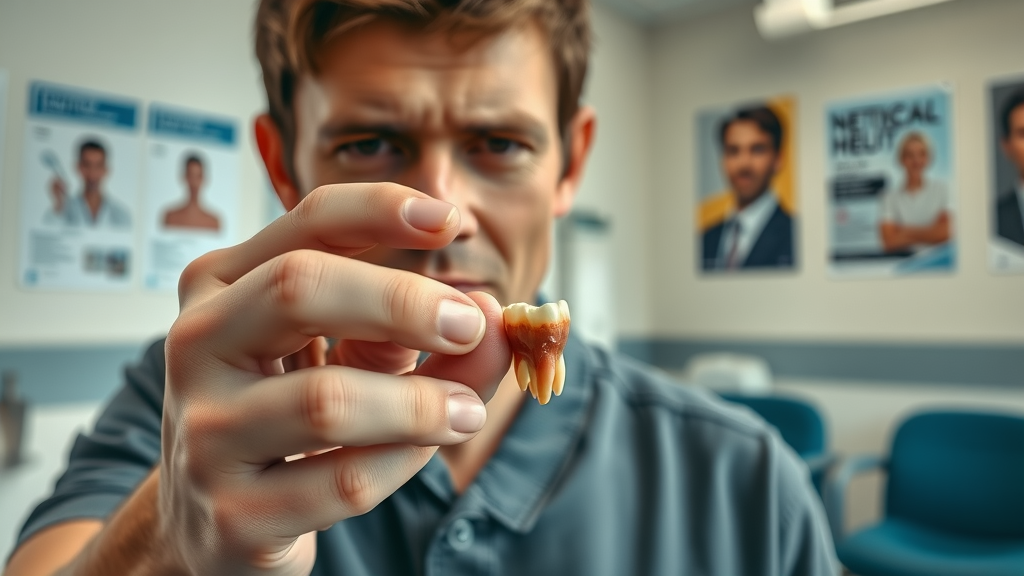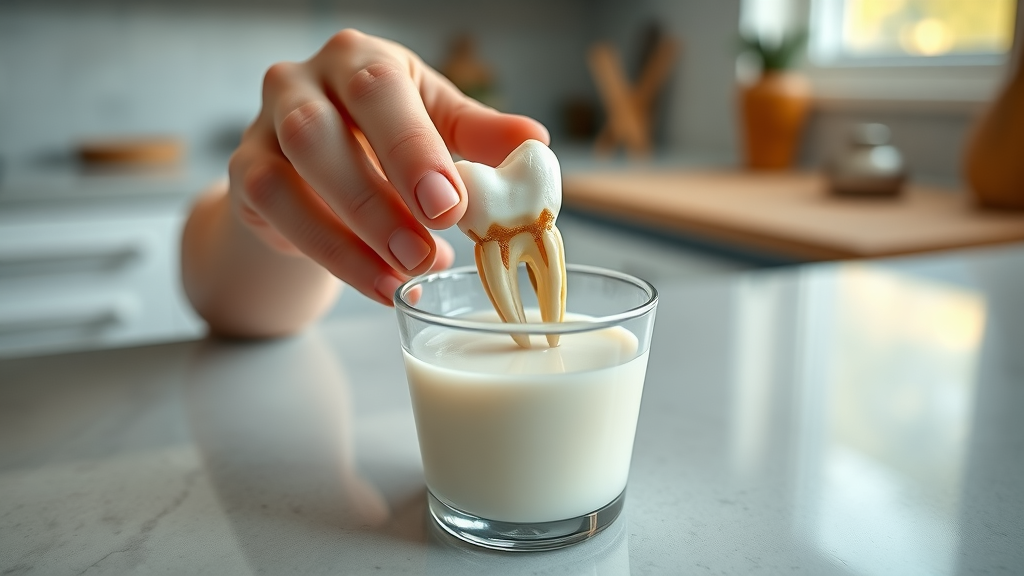Did you know? Acting within 30 minutes of knocking out a tooth can significantly improve the chances of saving it. When dental emergencies happen, time is of the essence. Whether it’s from a sports injury, a fall, or an unfortunate accident during daily activities, knowing what should I do if I knock out a tooth could make the difference between saving your natural smile and facing long-term dental work. In this guide, we break down exactly what you need to do—immediately and confidently—to give your tooth the best chance of survival and keep your oral health on track. Don’t let panic set in—important and practical advice is just a scroll away.
"Did you know? Acting within 30 minutes of knocking out a tooth can significantly improve the chances of saving it."

A Startling Fact: Why Fast Action Matters When You Knock Out a Tooth
When it comes to dental emergencies like a knocked out tooth, every minute counts. Research shows that if you act within 30 minutes, your chances of successfully saving your tooth are markedly higher. Delaying action—even by an hour—can decrease the tooth’s viability, making permanent reimplantation less likely and increasing the odds you’ll need a replacement solution such as implants or bridges. This is because the living tissue on the root of the tooth, called the periodontal ligament, quickly dries out and dies once it’s outside the mouth. For both adults and children, knowing what should I do if I knock out a tooth ensures you’re prepared should a dental emergency strike. Taking rapid, correct first aid steps not only increases the likelihood of saving your natural tooth but also protects your long-term oral health, helping you avoid complex dental treatments, unexpected costs, or gaps in your smile.
Fast action is crucial as it gives dental professionals more options to treat you and restore your dental health. The steps you take in those first critical moments—how you handle the tooth, how you keep it moist, and how soon you reach a dentist—can all contribute to your outcome. Whether you are caring for your own tooth or helping someone else, having a plan in place is the best way to ensure you react decisively, protect your teeth, and minimize complications.
What You'll Learn: How to Respond When a Tooth Is Knocked Out
Immediate steps to take if you knock out a tooth
How to preserve a tooth until you see a dentist
Differences between handling a knocked out baby tooth and an adult tooth
Expert-recommended strategies to protect your teeth in emergencies
In situations where a knocked-out tooth cannot be saved, your dentist may discuss restorative options such as dental implants to restore both function and aesthetics. If you’re curious about how dental implants work and what to expect from the procedure, you can find a comprehensive overview in our detailed guide to dental implants.
Understanding Tooth Avulsion: What Should I Do If I Knock Out a Tooth?
Tooth avulsion is the dental term describing a tooth that has been completely knocked out of its socket. This differs from a chipped or loosened tooth because the entire tooth structure—including the root—has been separated from the bone and tissue that surrounds it. If you’re asking, “what should I do if I knock out a tooth?” you’ve likely experienced this traumatic event or want to be prepared. Acting fast is vital, because you only have a very short window—about 30 to 60 minutes—to maximize the tooth’s survival. Every step, from picking up the tooth properly to getting expert help swiftly, matters for your oral health and the success of future treatment.
Understanding what happens during tooth avulsion can help you minimize panic and make informed decisions. It’s more common than you might think, especially among athletes, children, and people involved in contact sports or accidents. Avulsed teeth happen fast and unexpectedly, but responding correctly can save you major time, expense, and dental trouble down the line.
How Does a Tooth Get Knocked Out? Exploring Common Causes
A tooth can be knocked out due to a number of causes, but most often it happens during accidents and high-impact activities. Contact sports like football, hockey, and basketball are primary culprits, especially in the absence of a well-fitted mouth guard. Even slips, trips, falls at home, playground mishaps, or collisions during recreational play can result in a tooth being forcibly removed from its socket. Beyond these, other situations like motor vehicle accidents, workplace injuries, or blunt trauma from objects may also lead to tooth avulsion. Understanding these scenarios can help you be proactive in protecting your teeth with appropriate gear like bite mouthguards, and by avoiding risky behaviors—like chewing on ice or opening packages with your teeth—that put undue pressure on your chewing surface and oral structure.
It’s important to note that both adults and children are at risk. While baby teeth and permanent teeth can both be affected, how you respond may differ slightly. Ultimately, by raising awareness of these common risks, you can set effective prevention strategies and respond confidently if you or a loved one does experience a dental emergency like knocked out teeth.

Can a Tooth Be Saved if Knocked Out? The Importance of Rapid Response
Yes, a tooth can often be saved if it’s knocked out, especially if you act quickly. The sooner a tooth is reimplanted into its socket or preserved properly, the better the chance the tissues around the root will reattach and heal. In dental emergencies like these, speed is everything—getting to a dentist within 30 minutes offers the best outcome. If you’re able to put the tooth back immediately after rinsing and handling it correctly, you dramatically increase the chances of it surviving long term. If self-reimplantation isn’t possible, keeping your tooth moist (never dry!) using milk or saline will preserve the root cells until you reach professional care.
The risks of delayed care are significant: failure to act may mean needing a root canal, artificial replacement, or dealing with long-term gaps that can impact the alignment of other teeth, jawbone health, and your smile’s appearance. Whether it’s a permanent tooth or an adult tooth, preserving it gives you the best quality of life and oral health after trauma. In rare cases, teeth that are out of the mouth for over an hour can sometimes still be saved but the longer the delay, the lower the prognosis.
First Aid Steps: What to Do When a Tooth Is Knocked Out
Stay calm and locate the knocked out tooth: Take a deep breath. Find the tooth quickly and avoid unnecessary handling.
Handle the tooth by the crown, not the root: Always pick up the tooth by the chewing surface (the white part, or crown). Avoid touching the root, which is covered in delicate tissue needed for reimplantation.
Rinse the tooth gently under water—only if dirty: Never scrub the tooth or remove any tissue fragments. A gentle rinse under tap water for a few seconds is sufficient.
If possible, put the tooth back in its socket immediately: Align the tooth by the crown and gently push it back into the empty socket with your finger or by gently biting down on a clean cloth.
Keep the tooth moist if you cannot put it back: Place the tooth in a container of milk, saline, or your own saliva. If nothing else is available, keep it inside your cheek (not recommended for small children who may swallow the tooth).
"Put the tooth back in its socket as soon as possible. If that's not possible, store it in milk or saliva to keep it moist." – American Association of Endodontists
Why You Should Keep the Tooth Moist and How to Do It
Keeping the tooth moist is a critical step for tooth preservation after it’s knocked out. The root’s delicate ligament cells will quickly die if allowed to dry out, making successful reimplantation much less likely. As soon as you retrieve the tooth, avoid wrapping it in tissue or letting it sit out in open air. If you cannot put the tooth back in its socket right away, you can use several methods to maintain moisture: store the tooth in a small container of milk, immerse it in saline solution, or keep it in your own saliva by holding it inside your cheek if you’re able. Never use plain water for extended periods—it can damage the tooth’s root cells due to its hypotonic nature. Proper moisture helps preserve the living tissue and save the tooth when you finally get to a dental care professional.
Your goal should be to recreate the natural environment for the tooth root as closely as possible. Milk is often considered the best widely available liquid because it is gentle on cells, has the right pH and mineral balance, and is usually easy to find in households or even at sports venues and schools. Specialized tooth preservation kits are available, but they are not always on hand during an emergency, so knowing home remedies is key to protecting your teeth in a crisis.

What Liquids Help: The Role of Milk, Saline, and Saliva in Tooth Preservation
Using milk, saline solution, or saliva remains the gold standard for short-term storage when you can’t immediately reinsert a permanent tooth back into its socket. Milk is high in nutrients and similar in osmolarity to the natural environment of a tooth root, making it excellent for preserving ligament cells for extended periods. Saline solution works well for tooth preservation, as it matches the salt content of your body and is gentle on the tooth’s surface. If neither are available, gently placing the tooth in your mouth—between your gums and cheek—keeps it surrounded by natural fluids. This should only be done by capable adults and not young children who might accidentally swallow the tooth.
Never store the tooth in plain tap water for more than a few seconds during a rinse (if dirty), as this can harm fragile root cells. Likewise, avoid cleaning the tooth with soap or chemicals, which can damage living tissue and decrease the odds of a successful reimplantation. The use of a tooth preservation kit is helpful in certain situations—especially for athletes or organizations who want to be prepared for dental emergencies—but these are not a substitute for immediate dental care. Whether it’s an adult or a child, keeping the tooth moist until you see a dentist is the most critical step you can take to give your natural tooth a fighting chance.
Common Mistakes to Avoid: Do Not Scrub or Dry the Tooth
During the chaos of a dental emergency, avoid the urge to “clean” the tooth excessively. Do not scrub or dry the tooth—scrubbing can damage the fragile cells necessary for the tooth to reattach to the jawbone. Similarly, drying it on paper towels or cloths causes the root surface to dry out and reduces the tooth’s chances of successful reimplantation. Never wrap the tooth, clean it with soap, bleach, or disinfectant, or attempt to scrub off any visible dirt or tissues. Instead, simply hold the tooth by the crown, quickly rinse under running tap water for no more than 10 seconds if dirty, and keep the root moist at all times.
Well-meaning mistakes can jeopardize the very outcome you’re working so hard to ensure. Avoiding these errors is just as important as taking the right steps. If you’re at all unsure about what to do, err on the side of caution and seek professional dental advice immediately. These common pitfalls are why it’s critical to educate yourself and your family so you’re prepared to protect your teeth in any emergency.
Special Scenarios: What to Do If a Baby Tooth Is Knocked Out
Knocking out a tooth is alarming for anyone, but with children, there are special considerations. If a baby tooth (also known as a primary tooth) is avulsed, the steps differ from those for a permanent or adult tooth. Attempting to put a baby tooth back can damage the developing permanent teeth beneath the gums. Instead, focus on controlling bleeding, comforting the child, and seeking advice from your dentist right away. The management for baby teeth centers on preventing infection, ensuring oral health, and monitoring for possible complications as the child grows.
It’s not always easy to tell whether it’s a baby tooth or an adult tooth, so when in doubt, consult with your family dentist promptly. Understanding these differences is crucial for parents, babysitters, teachers, and caregivers alike, ensuring prompt, safe decisions when dealing with a child’s dental emergency.
Is It Different for Baby Teeth?
Absolutely! Baby teeth and adult teeth are treated very differently when it comes to avulsion. When a baby tooth is knocked out, reimplantation is generally not recommended. Reinserting a primary tooth could cause harm to the permanent tooth that’s developing beneath it, possibly resulting in future alignment or health issues. Instead, gently rinse the child’s mouth with water, apply a cold compress to minimize swelling, and contact your dental care professional for advice as soon as possible. Your dentist will assess the situation and may want to take x-rays or schedule a follow-up to ensure the child’s oral health remains intact and that no fragments remain.
The loss of a baby tooth can still be frightening and painful, and young patients may have severe anxiety after the event. Comforting your child and seeking expert advice quickly will ensure the best outlook for both their oral and emotional health. The dentist may recommend steps for managing pain, preventing infection, or, if needed, discussing temporary solutions until the permanent tooth erupts. Above all, never attempt to put a baby tooth back in the socket.
Why You Should Not Put a Baby Tooth Back
The primary reason you should not put a baby tooth back is the risk of damaging the underlying permanent tooth bud—which can affect the child’s smile for years to come. The developing adult tooth is vulnerable to trauma if a knocked out baby tooth is forced back into place. Dentists recommend allowing the natural healing process to occur and monitoring for signs of swelling, infection, or delayed eruption in the future. Preserving your child’s oral health means prioritizing caution and leaning on professional guidance for the best results.
Additionally, attempting to reinsert a baby tooth may introduce bacteria into healing tissues or increase the risk of infection. It may also cause the tooth to re-fuse in an abnormal position, resulting in challenges as permanent teeth emerge. Always seek the expertise of a pediatric dentist or family dental care provider for recommendations specific to your child’s needs.

Put the Tooth Back: When and How to Reinsert a Knocked-Out Tooth
If you’re dealing with a permanent or adult tooth, putting the tooth back into the socket as soon as possible greatly increases the odds of successful reimplantation. The most important step is to ensure you are handling the tooth by the crown, not the root. Whether the accident occurred at home, at school, or on the field, you should first gently rinse the tooth under tap water if dirty, then quickly reposition it. If you can achieve this within the critical 30-minute window, the chances of the tooth’s ligament cells surviving—and therefore reconnecting to the bone—increase dramatically. Take extra care in aligning the tooth correctly and avoid wiggling or forcing it, which can damage both the root and socket.
Not every situation will allow for immediate reimplantation—an uncooperative or anxious patient, visible debris that won’t rinse off, or other injuries may complicate the process. If you cannot put the tooth back in, focus on keeping it moist in milk, saline, or (as a last resort) saliva, and get to your dental care provider immediately. Your dentist will perform any necessary adjustments and provide pain relief, antibiotics (if needed), and a care plan tailored to restore your oral health.
How to Safely Put the Tooth Back in Its Socket
Here’s the expert-recommended process for safe reimplantation:
Handle with care: Hold the tooth by the crown. Avoid touching the root at all costs, to protect living tissue that can promote healing.
Gently rinse: If the tooth is dirty, rinse briefly under cool tap water—no scrubbing!
Align and reinsert: Line up the tooth with the empty socket and gently push it into place—don’t force it. A slight pressure with your finger or a firm, gentle bite on a piece of gauze or cloth can help keep it steady.
Stabilize and seek care: As soon as possible, see your dentist or an emergency dental clinic for follow-up and professional stabilization (splinting).
If you feel nervous about doing this yourself, keep the tooth moist as described earlier, and hurry to the dentist. Remember: every moment counts when it comes to dental emergencies and the survival of a knocked out tooth.
When to Seek Professional Dental Care After a Tooth Is Knocked Out
Even if you have taken all the right first aid steps after your tooth is knocked out, professional dental care is non-negotiable for the best outcome. A dentist will examine your mouth for additional injuries, ensure the tooth is correctly positioned, and may use splinting techniques to secure the tooth during the healing period. They will also watch for signs of infection, nerve damage, or the need for a root canal. It’s crucial to see a dentist within 30 minutes if possible, but late presentation is better than none at all. Your dentist may order x-rays to check for jaw or facial injuries and give instructions for home oral care and diet as you recover.
In some cases, especially children or patients experiencing heavy bleeding, facial trauma, or unconsciousness, an emergency room (ER) visit is necessary. The ER staff can manage acute injuries and help stabilize you for a follow-up with a dental professional. For most dental emergencies, however, a general or emergency dentist is the most appropriate resource.
Do You Need to Visit the ER for a Knocked Out Tooth?
For most dental emergencies involving knocked out teeth, a trip to a specialized dental clinic is usually the best choice—dentists have the expertise and tools to manage the reimplantation, stabilization, and follow-up care. However, consider the ER if you have significant head or facial trauma, cannot control bleeding, suspect jaw fracture, or your regular dentist is closed and you have no access to emergency dental care. The ER can address acute pain and life-threatening injuries and refer you for rapid dental follow-up if needed.
Timely referral is key: The sooner you see a dentist, the better the odds of saving your tooth. Ideally, seek care within 30 minutes. If you’re unsure, call ahead for advice. The healthcare team at Johnstown Dental Care or your local provider can help guide you on the best next steps to protect your teeth and oral health.
"The sooner you see a dentist, the better the odds of saving your tooth. Ideally, seek care within 30 minutes."
How Dentists Treat Knocked-Out Teeth: What to Expect at Your Appointment
Time Since Injury |
Possible Treatments |
Chance to Save Tooth |
|---|---|---|
Less than 30 minutes |
Reimplantation, stabilization |
High |
30–60 minutes |
Reimplantation, possible root canal |
Moderate |
Over 60 minutes |
Reduced viability, possible replacement |
Low |
At your dental appointment, the team will first evaluate your general oral health, attempt to reimplant or stabilize the tooth if it hasn’t already been done, and may prescribe antibiotics to prevent infection. A root canal may be required to maintain the tooth’s health over the long term. If the tooth cannot be saved, they’ll discuss options like implants, bridges, or partial dentures to best restore your smile and bite function. Follow their aftercare advice closely to support optimal healing and keep your mouth healthy.
Protect Your Teeth: Tips to Prevent Tooth Injuries in the Future
Wear mouthguards during sports: Athletes and active children should always use a properly fitted mouth guard to shield teeth from blows, falls, and accidental impacts. Mouth guards are essential for all contact sports.
Avoid risky behaviors and hard foods: Don’t use your teeth as tools to open packaging or bottles, and stay away from chewing on ice, popcorn kernels, or hard candy that can fracture teeth.
Maintain regular dental check-ups: Consistent visits to your dentist help spot weak teeth, prevent oral health issues, and keep your smile resilient against future accidents.
Adopting these preventive habits will help protect your teeth and reduce the chances of dental emergencies from disrupting your life. Remember, small changes—like using a mouth guard or staying mindful when eating—can have a big impact on your lifelong oral health.

People Also Ask: What to Do If You Knock Out a Tooth?
What to do if you knock out a tooth?
Answer: Act fast. Handle the tooth by the crown, gently rinse it, try to put it back in the socket, or keep it moist. See a dentist immediately.
What to do if you accidentally pull out a tooth?
Answer: Treat as a knocked out tooth: keep it moist, avoid touching roots, and get to a dentist quickly to maximize chances of successful reimplantation.
Can a tooth be saved if knocked out?
Answer: Yes, especially if reimplanted within the first hour. Quick and proper action is key.
Should you go to the ER for a knocked out tooth?
Answer: Visit a dentist urgently, but if there are other injuries or heavy bleeding, or if the dentist is unavailable, head to the ER.
FAQs About What Should I Do If I Knock Out a Tooth
How long can a knocked out tooth survive outside the mouth? – Generally, a tooth has the best chance of survival if replaced or stored within 30–60 minutes. Beyond that, the likelihood of saving the tooth decreases rapidly.
What should I avoid when handling a knocked out tooth? – Don’t touch the root, scrub the tooth, or let it dry out. Never use soap or harsh chemicals for cleaning and avoid wrapping it in tissue or cloth.
Is it okay to clean the knocked out tooth with soap? – No. Gently rinsing with water is sufficient; soap or disinfectants can kill the root cells needed for successful healing.
What can I do if I can’t see a dentist immediately? – Keep the tooth moist in milk, saline, or your saliva, and call an emergency dental clinic. Avoid letting it dry out and seek professional help as soon as possible.
Key Takeaways: What Should I Do If I Knock Out a Tooth
Act quickly and handle the tooth properly
Keep the tooth moist at all times
Seek professional dental care as soon as possible
Do not attempt to reinsert baby teeth
Conclusion: Be Prepared—Knowing What to Do If You Knock Out a Tooth Can Save Your Smile
Acting fast, handling the tooth with care, and getting prompt expert help are your best defenses to save your tooth and your smile in a dental emergency.
If you’re interested in taking your oral health knowledge even further, consider learning about the advanced training and patient-focused approach of our dental team. Discover how our expertise in both emergency care and long-term solutions can help you maintain a healthy, confident smile for years to come by visiting our meet the doctors page. Empower yourself with the right information and a trusted dental partner—because being prepared is the best way to protect your smile, no matter what life throws your way.
Contact an Emergency Dentist: Johnstown Dental Care
For immediate help, contact Johnstown Dental Care, 370 West Coshocton St., Johnstown, OH 43031;
Phone: (470) 967-6046.
Proudly serving Johnstown, New Albany, Granville, Alexandria, Pataskala, and surrounding areas in Licking County, Franklin County, and Delaware County.
When a tooth is knocked out, immediate and appropriate action is crucial to increase the chances of saving it. The National Health Service (NHS) advises that you can usually save a knocked-out tooth by either putting it back in place or storing it in milk as soon as possible before seeing a dentist. (nhs.uk)
Similarly, the Oral Health Foundation recommends that if the tooth is clean and if you can, try to put the tooth back in. Hold the tooth by the crown and place it firmly back into the socket. Bite on a clean handkerchief for 15-20 minutes. (dentalhealth.org)
By following these expert guidelines, you can take immediate steps to preserve the tooth and seek professional dental care promptly.
 Add Row
Add Row  Add
Add 




Write A Comment